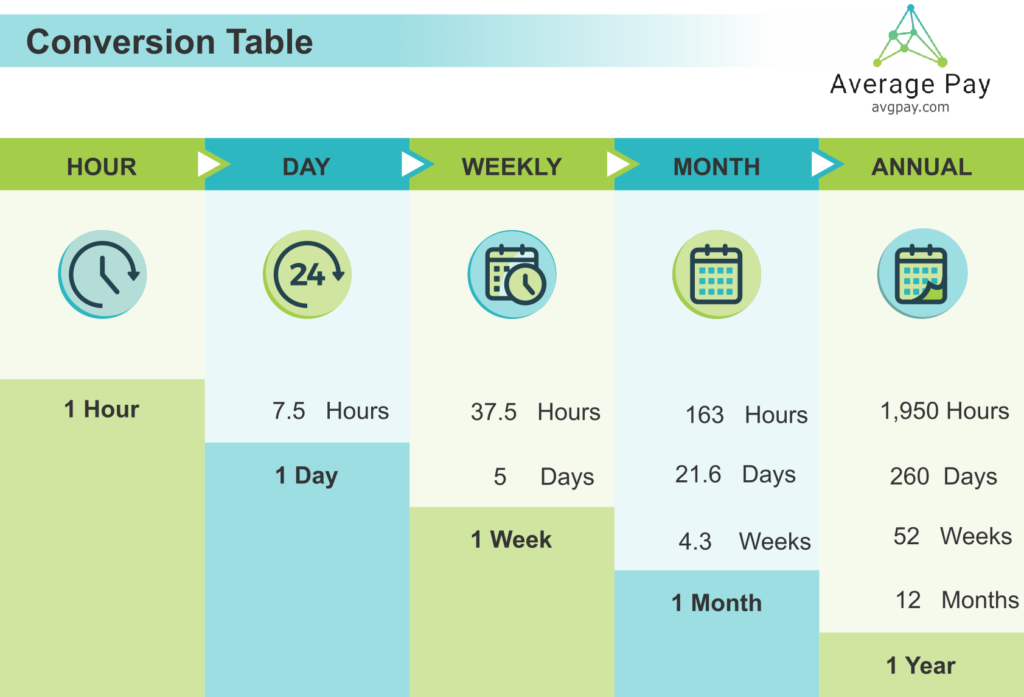How Much is $43,017 a Year Equal to Per Hour?
When you’re working a job that pays an annual gross salary of $43,017, it can be hard to figure out what your hourly wage is. It’s even more complicated when you’re trying to compare salaries from different jobs. We will break down exactly how much $43,017 a year equals per hour. We’ll also compare it to different pay periods and frequencies.

$43,017 a year is how much per hour?
To calculate your hourly wage from an annual salary, you need to divide the total yearly amount by the number of hours you work in a year. There are many different ways to figure out how many hours you work in a year. The most common way is to assume that you work 40 hours per week for 52 weeks in a year. This would give you a total of 2080 hours worked in a year.
If you divide $43,017 by 2080 hours, you get an hourly wage of $20.68
However, this calculation doesn’t take into account paid vacation time that you may have and not including federal holidays.
$43,017 is How Much a Year After Taxes?
At a wage of $20.68 dollars an hour, after taxes is about $39,293 in annual income or your net salary compared to the yearly salary before taxes when you are done paying taxes on your income.
The amount of taxes you pay will depend on your tax bracket but for this yearly income you are in the 22% tax bracket, and you will owe about $3,724.00 in taxes on a $43,017 yearly salary. That leaves you with take-home pay of $39,293 just for federal taxes, so there will be more for state taxes and FICA and State Insurance Taxes.
$43,017 is How Much a Month?
Your monthly salary is simply your yearly salary divided by 12. This means that if you make $43,017 a year, you would make $3,585 a month. After taxes, your monthly salary would be $3,274 with a tax rate of 22% which doesn’t include state taxes, pre tax deductions or FICA and State Insurance Taxes.
Comparison Table of $43,017 as an Annual Salary (Before & After Taxes)
Table of $43,017 Yearly Salary Before and After Taxes by Pay Frequency
Pay Frequency
Before Tax Income
After Tax Income
Yearly (12 Months)
Monthly (4.34 Weeks)
Biweekly (80 Hours)
$1654.4
Weekly (40 Hours)
Daily (8 Hours)
Hourly (1 Hour)
How Much Is $43,017 a Year Every Two Weeks (Biweekly salary)?
Your salary may not be paid out to you in yearly increments. Some employers pay their employees every bi-weekly. Assuming you aren’t working part-time and you work 40 hours per week, then you will be working 80 hours for both of the weeks.
For two weeks at 80 hours your biweekly salary will be $1654.4 before taxes and $1,511 after income taxes at a tax rate of 22%.
$43,017 is How Much a Week?
Your weekly salary is your annual salary divided by 52. This means that if you make $43,017 a year, you would make $827 for a weekly income before taxes. After taxes, your weekly salary would be $756 with a tax rate of 22% which doesn’t include state taxes or FICA and State Insurance Taxes.
How Much Is $43,017 a Day?
Your daily salary would be your hourly rate times the number of hours you work. If you make $43,017 a year and work a standard 40-hour week, your average hourly wage is $20.68 an hour before taxes ($43,017 / 2080 hours = $20.68). You can also take your weekly salary and divide by 5.
This means that if you work an eight-hour day, your daily salary before taxes would be $165.44. After taxes, your daily salary would be $151.12 with a tax rate of 22% which doesn’t include state taxes or FICA and State Insurance Taxes.
The differences in Salary vs Hourly Wages?
A salary is an annual amount that is paid out to you in installments throughout the year. An hourly wage is the amount of money you make for each hour that you work.
The main difference between these two types of compensation is that a salary is usually a set amount, while an hourly wage is on a per hour basis and can fluctuate based on the number of hours worked.
When you’re considering a new job, it’s important to look at the overall compensation package and determine which type of compensation is best for you. If you’re looking for stability and a guaranteed income, then a salary may be the best option. If you’re more interested in earning potential and flexibility, then an hourly wage may be the better choice.
Pros and Cons of a Job with a Salary Income vs an Hourly Wage?
There are advantages and disadvantages to both a salary and an hourly wage.
Some of the advantages of a salary include:
More stable income
Easier to budget
Often comes with benefits like health insurance and vacation days
Some of the disadvantages of a salary include:
Less opportunity for overtime pay
Possibility to have to work more hours than expected
Requires more commitment
Some of the advantages of an hourly wage include:
Can earn overtime pay for working extra hours
More flexible schedule
Might be able to negotiate a higher hourly rate
Some of the disadvantages of an hourly wage include:
Income can be less stable
Difficult to budget since hours can fluctuate
Often doesn’t come with benefits like health insurance or vacation days
At the end of the day, it’s important to choose the compensation package that is best for you and your situation. If you’re looking for stability, a salary may be the way to go. If you’re more interested in earning potential and flexibility, then an hourly wage may be a better option.
